Soba Noodles: Their Calorie Content, Ingredients And Where To Eat Them

Soba, or buckwheat noodles, have been a classic Japanese food for centuries. Find out more about the regional soba dishes to try, how to eat zaru soba and other varieties, and recommended restaurants in Japan. This article also introduces calories and prices of these healthy, inexpensive noodles.
Soba - Tasty Buckwheat Noodles
Soba, or buckwheat, is one of the representative foods of Japan. Buckwheat seeds are pulverized and ground down into a powder, then mixed with water and kneaded into a dough, which is then made into long thin noodles, boiled and eaten.
Dried bonito and kombu (kelp) are made into a dashi stock, and added to soy sauce to create the perfect sauce or soup base, soba tsuyu.
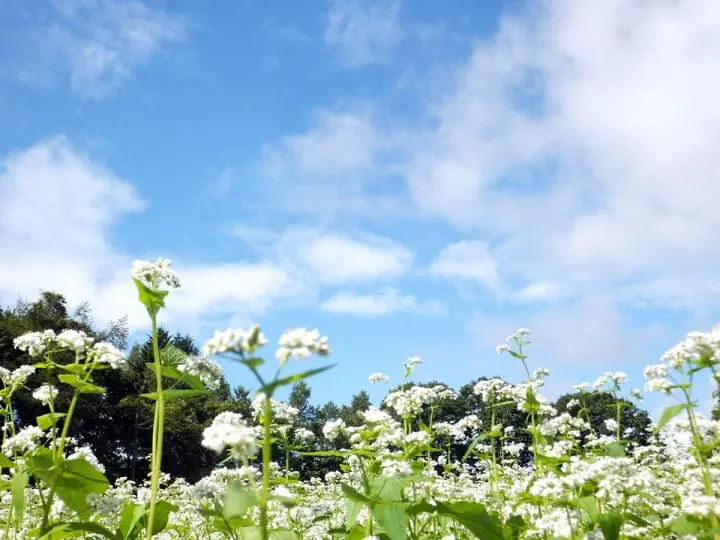
Soba has a long history in Japan; it is said that buckwheat has been cultivated in Japan for about 10,000 years, since the Jomon period.
Today, from standing soba shops in train stations to high class restaurants, soba noodles can be enjoyed at different places throughout Japan. It is also said to be one of the foods most freely enjoyed in Japan. There are many different varieties of soba, from hot to cold, ones with tempura on top and more. In this article we will outline some of the many charms of these delicious noodles that visitors to Japan can enjoy.
Table of Contents:
1. Types of Soba
2. How to Eat Soba and its Condiments
3. The Nutrients and Calories in Soba
4. Unusual Soba and Regional Dishes
5. Differences in Soba in Kanto and Kansai
6. Soba Prices, Chains and Recommended Shops
7. Soba Allergy
Types of Soba
There are many different types of toppings available for soba, each creating a dish variation with a unique name. Kake soba, zaru soba, mori soba, others - other than hot and cold soba, you should try some of the various types to see which suits you best.
Kake soba
Kake soba is a simple soba featuring hot noodles in a broth, sometimes seasoned with green onions. This was said to have been invented during the Edo era as a fast food of sorts for package delivery workers; the noodles and sauce were already together in one dish, making it something they could quickly slurp up.
Mori Soba and Zaru Soba

Mori soba and zaru soba are noodles that have been boiled then chilled and placed on top of a bamboo plate and served with a dish of tsuyu to dip the noodles in. If the noodles come with shredded nori seaweed on them, then they are called zarusoba, if not, morisoba.
Kakiage
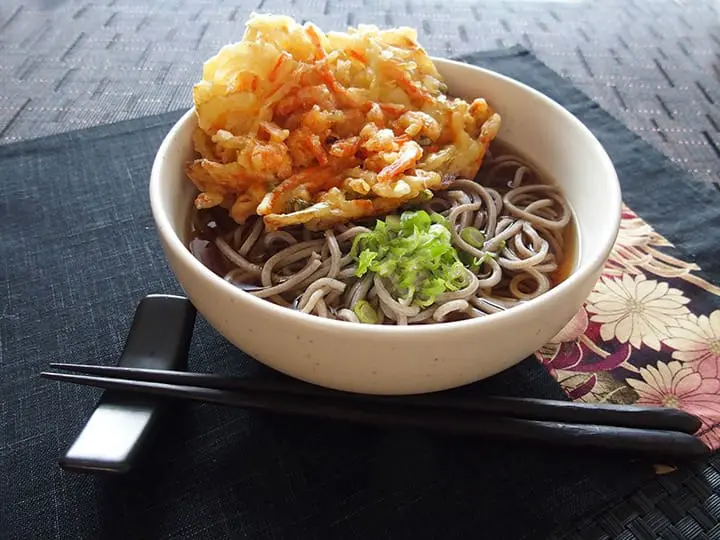
Kakiage are a type of tempura, made up of finely cut onions, shrimp and other vegetables - they resemble a fried vegetable cake. Kakiage soba is a hot soba dish with one of these cakes on top. It is a great dish where you can really taste the sweetness of the vegetables in the cake well.
Tempura Soba
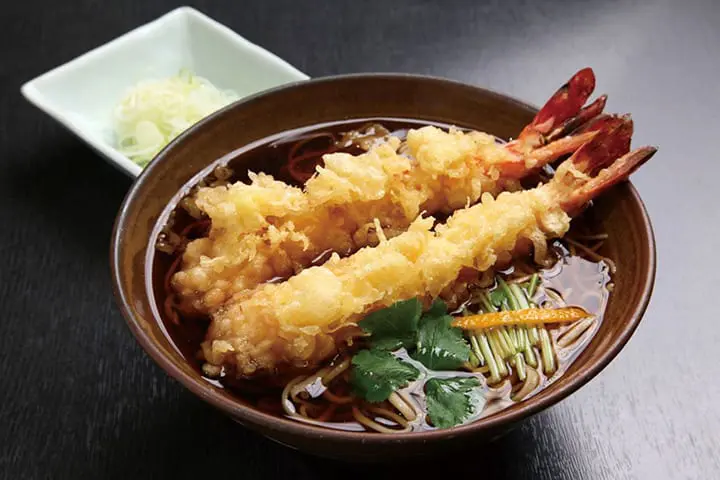
Soba eaten with shrimp and or vegetable tempura. There are both hot and cold varieties of this dish. The tender texture of the shrimp is one of the most appealing points of this dish.
Okame
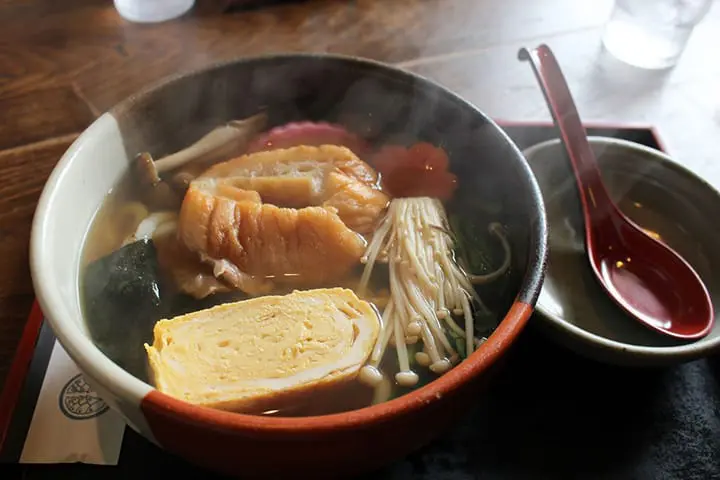
This is a type of kake soba with kamaboko, spinach and other ingredients in the soup.
Kitsune Soba
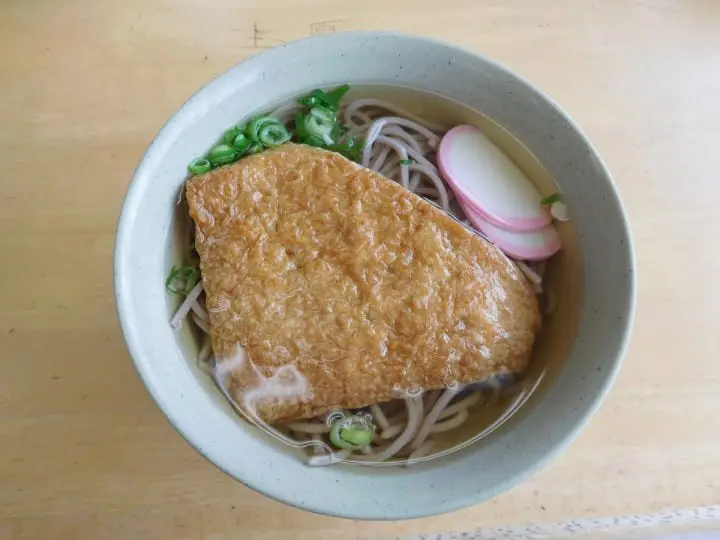
Another type of kake soba, this one comes with a slice of fried sweet tofu in the soup. In Japan kitsune, or foxes, are said to love these slices of fried tofu, which is how this dish got its name. The combination of the sweet tofu with the tsuyu has a very relaxing flavor to it.
Tanuki Soba
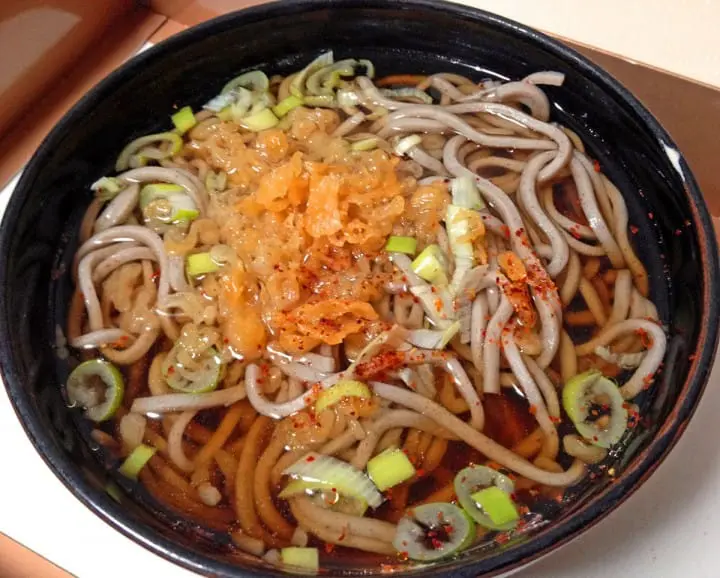
Tanuki soba is a type of kake soba with crumbs of fried tempura batter (tenkasu) in it. Of all the types of soba, this is perhaps one of the lowest price types around.
Oroshi Soba
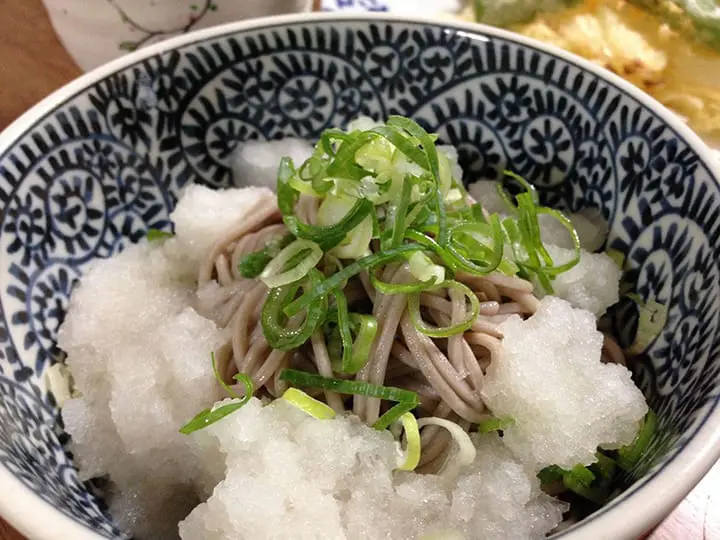
Oroshi soba is a cold soba with daikon oroshi, or grated daikon radish, in it. The cool, refreshing taste of this dish makes it ideal in the summer time.
Tororo (Yamakake)
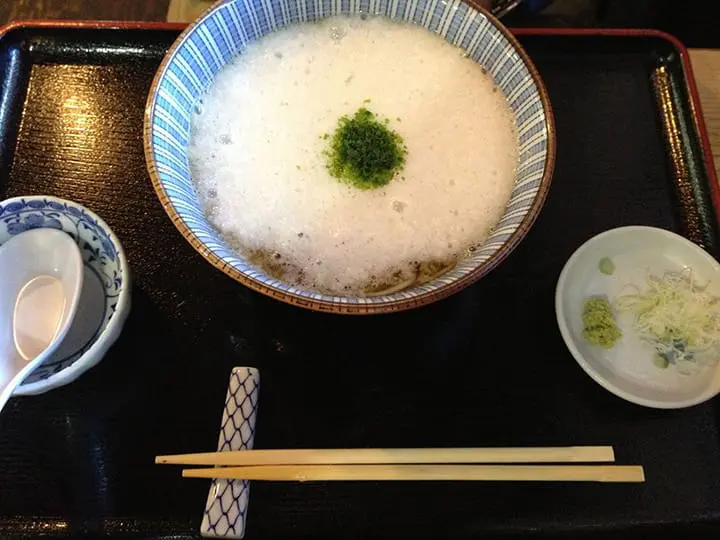
This soba dish features grated Japanese or Chinese yam in it (yamaimo or nagaimo), and comes in both hot and cold varieties. The stickiness and flavors of the yams are an excellent match to soba.
Sansai
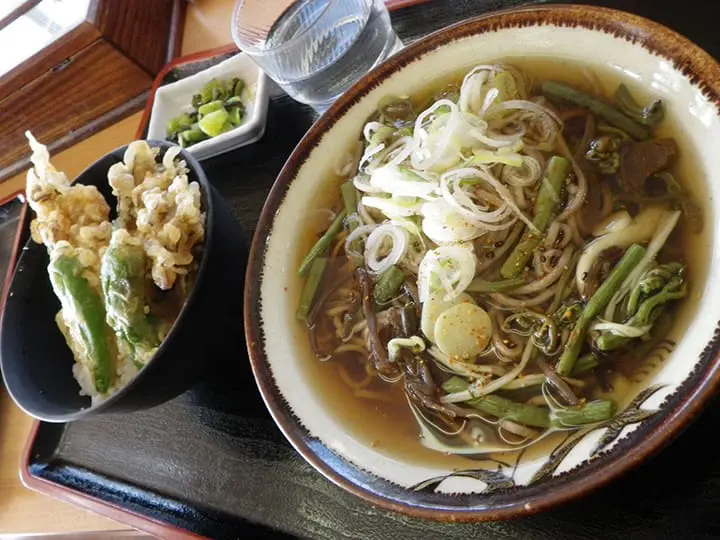
Sansai means edible wild plants in Japanese, and that is exactly what is found in this soba dish: zenmai (royal fern or fiddlehead fern), takenoko (bamboo root) and other safe wild plants are gathered and served in the soup. This dish also comes in both hot and cold types. The simple flavors of the wild plants are delicious; this is a dish you should try when visiting a mountainous area as this is where the majority of the wild plants are found.
Nameko
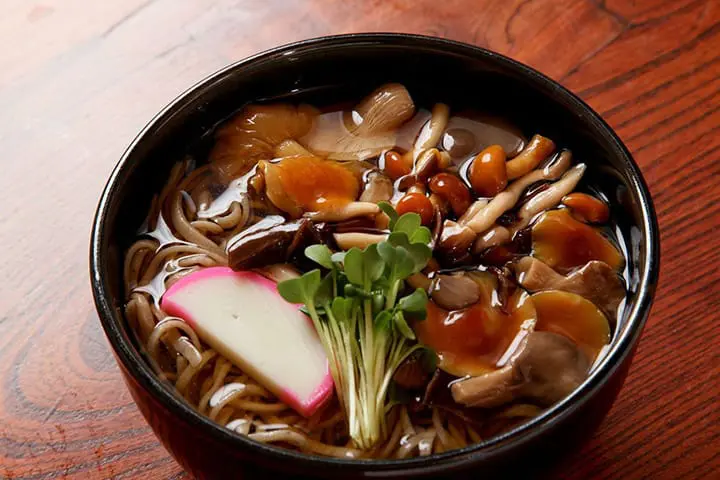
This type of soba features the unusual nameko mushrooms, which possess a gelatinous outer skin, and give this dish an overall unique mouth feel. The jelly-like texture of the mushrooms helps this dish to easily slide down your throat. This kind of soba comes in both hot and cold varieties.
Tsukimi Soba
This is a type of soba with either a raw egg or a soft-boiled egg in it. By adding an egg, the overall flavor of the dish becomes much richer. If you are not a fan of raw eggs or have never tried them before, then this dish might not be the best for you, and we don't really recommend trying cold tsukimi soba either.
Tamago-toji
This is another type of egg and soba dish, although quite different from tsukimi soba. In this dish, the eggs are soft-scrambled in the tsuyu soup and are quite delicious; this is also another hot soba dish.
Kamo-nanban Soba
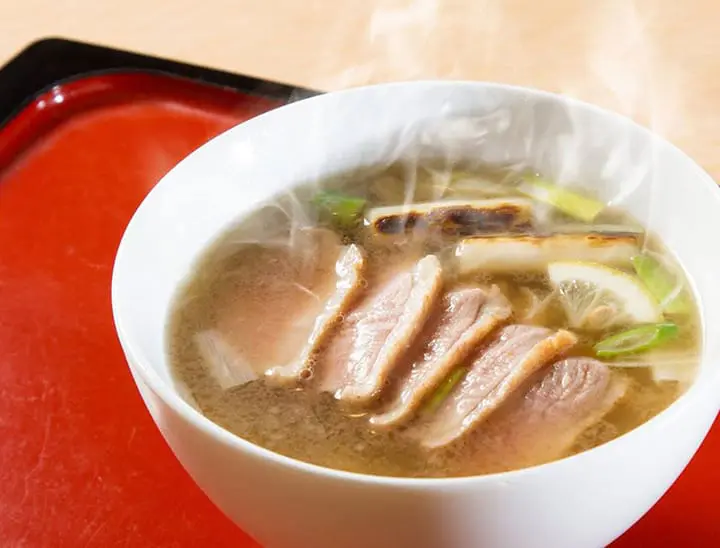
This type of kake soba features duck meat and green onions in the soup. This dish originally featured standard onions, but during the Edo era when people from Portugal and Holland (called nanban, or 'southern barbarians' in Japanese) came to Japan, they exchanged the onions for green onions, and thus inspired the name.
Nishin Soba
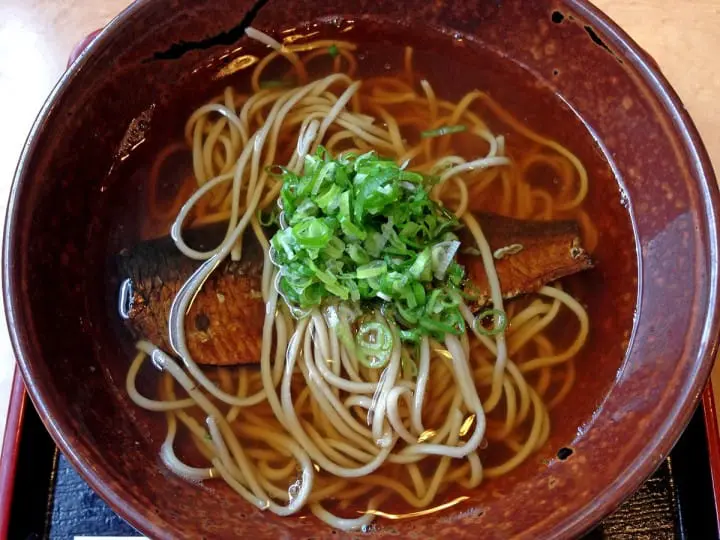
This is another type of kake soba with a topping of dried sliced herring on it. This dish is very popular in Hokkaido, where the herring is caught, and in Kyoto, where preserved sweetened boiled fish like herring is popularly eaten.
Hanamaki Soba
This is a kake soba featuring bite-sized pieces of dried nori seaweed on top. The flavor of the nori is said to really get your appetite going.
Curry Soba
This is a hot soba dish where curry powder has been added to the tsuyu soup base; in Japan, curry udon is also quite popular.
Sobagaki
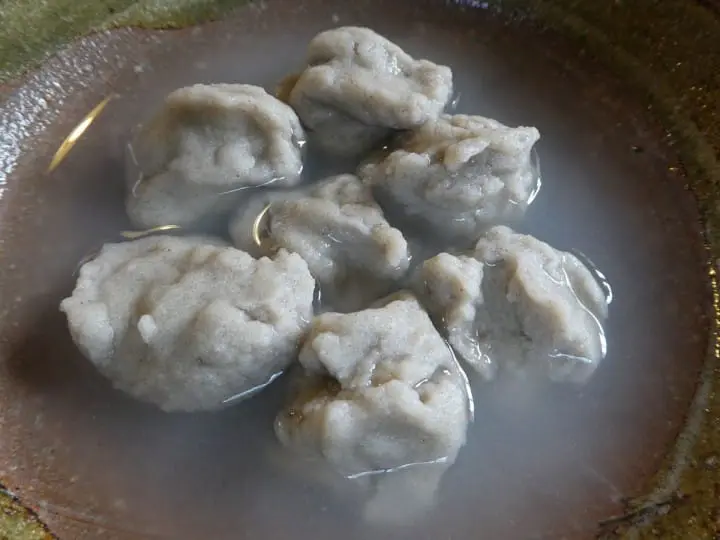
This dish features softly kneaded buckwheat dough that has been shaped into round dumplings and boiled. Served with dashi stock or wasabi salt, they are an excellent match with sake. If paired with well-boiled adzuki beans, these dumplings can also be eaten as dessert. Before soba dough was made into noodles, sobagaki were the standard way of eating this dish. In contrast to sobagaki, the noodles are also referred to as sobakiri.
Cha Soba and Ume
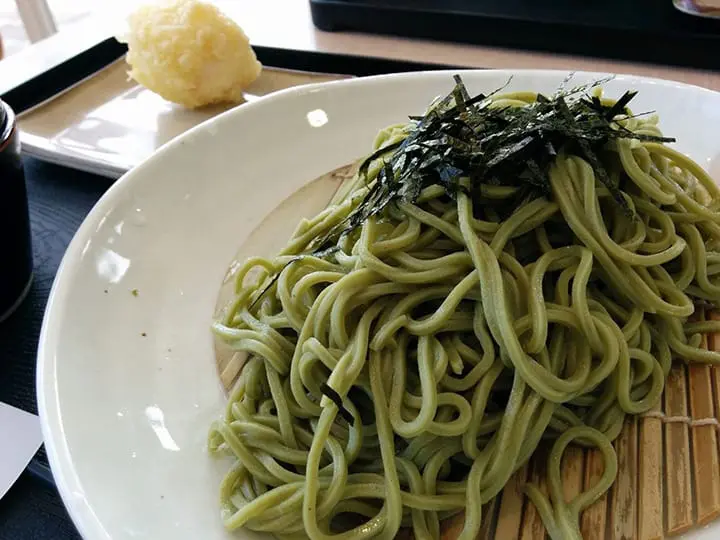
This is a different type of soba noodle; green tea is added to the dough, which gives these noodles a light, naturally green color. Ume soba is another type of hued-noodle; plums are added to the dough, giving them a natural pink color.
Toshikoshi Soba
This is a key part of Japanese New Year customs; this type of hot kake soba is eaten on Omisoka, or December 31st. The long, thin soba noodles are said to represent long life and longevity, which is why they are eaten in the hopes of achieving both.
Chukasoba (Shinasoba)
This is technically a type of ramen noodle rather than soba; it means Chinese soba. It is not actually made with buckwheat flour.
The Nutrients and Calories in Soba
Soba is a comparatively healthy food.
An individual serving of soba noodles contains roughly 300-400 calories and has lots of vitamins B1 and B2, lutein, dietary fiber, minerals, and protein, with very little fat. It also has a hypo-glycemic Index (GI) level, making it a suitable dish for dieters.
If you add tempura or kakiage to your soba, then it will come in at around 500 calories per serving. If you are on a diet or trying to eat more healthily, then kake soba, zaru soba, otafuku soba, and soba with simple toppings are best for you.
The Difference Between Soba and Udon
Soba noodles, as we have said, are long, thin noodles made from buckwheat flour, while udon are thick, springy noodles made from wheat flour. Both may be served hot or cold with tsuyu, and as such, general restaurants selling soba often also have udon on the menu.
How to Eat Soba and its Condiments
There is one sight that is sure to surprise visitors to Japan, and that is the behavior of the Japanese when eating noodles. The Japanese, when eating noodles, tend to noisily slurp them, which is considered poor manners in most other countries. To eat long noodles properly with chopsticks, and to fully enjoy the noodles themselves and their tsuyu and other seasonings - these are the two reasons that the Japanese slurp their noodles.
Without exception, the Japanese think that slurping soba noodles is the best way to eat them. So when eating soba in Japan, why not do as the Japanese do and slurp your own soba noodles?
Soba comes in three main different forms: noodles in hot soup, cold noodles with a tsuyu dipping broth, or cold noodles that you pour the cold soup base on top of. Now let's take a closer look at the different ways of eating these noodles.
How to Eat Hot Soba
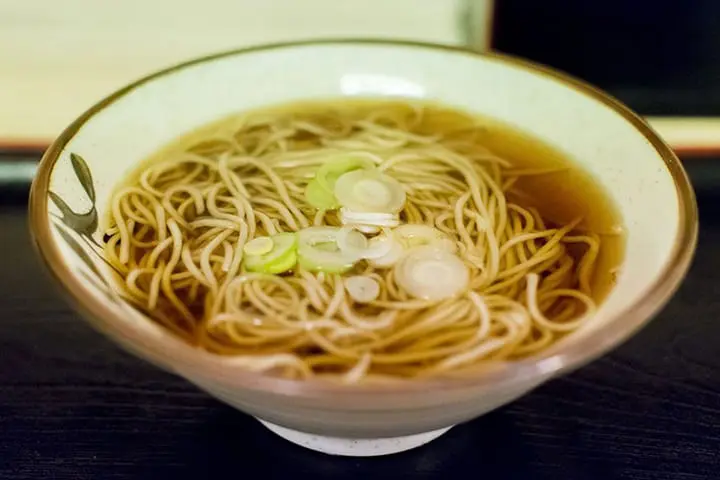
Kake soba, or soba noodles in hot broth, can be topped with green onions, shichimi spices (seven pepper blend) or other seasonings to suit your tastes. Usually, when eating ramen, the dish comes with a large flat spoon so that you can scoop up the broth, but with soba, you are not typically given this spoon. In that case, it is perfectly acceptable to drink the broth straight from the bowl. But if you would prefer a spoon, you can also ask the staff for one.
The one caution is that, the noodles will absorb the soup and lose their own unique flavor the longer you leave them, so it is best to eat the soba while it is still hot.
How to Eat Cold Soba (Zaru Soba)

If you order zaru soba, you will receive a plate of cold soba noodles and a small, separate dish with cold tsuyu dipping sauce in it. When eating zaru soba, you should pick up a mouthful size serving of the noodles, dip it in the sauce and then eat it. The strength or saltiness of the tsuyu differs from restaurant to restaurant, so when you first dip your noodles in to it, be careful not to take up too much sauce.
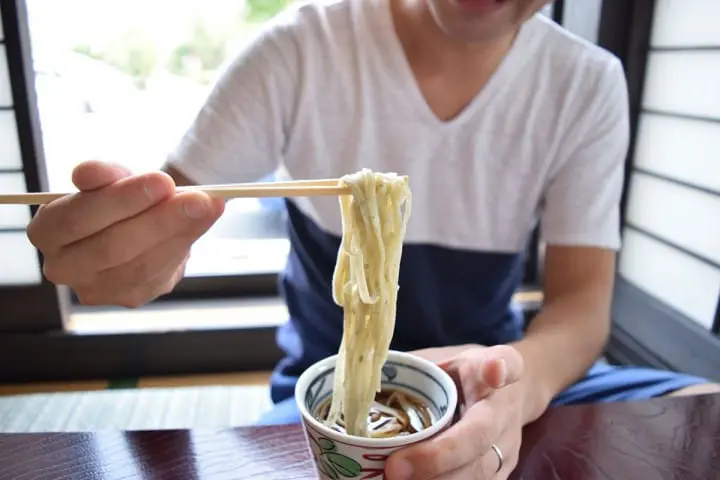
And just like with hot soba, you can add green onions, shichimi, wasabi or other condiments to suit your tastes to the cold tsuyu.
Hiyashi Soba
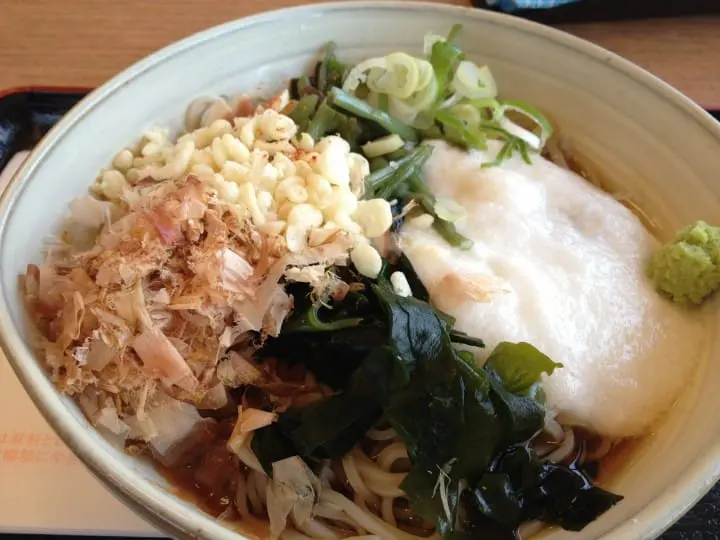
Other than zaru soba, there are also types of cold soba. Many of these types feature soba and other ingredients in a bowl, over which you pour the tsuyu yourself. In this case, you are meant to mix up the noodles and the ingredients with your chopsticks before eating it.
The Condiments in Soba Dishes
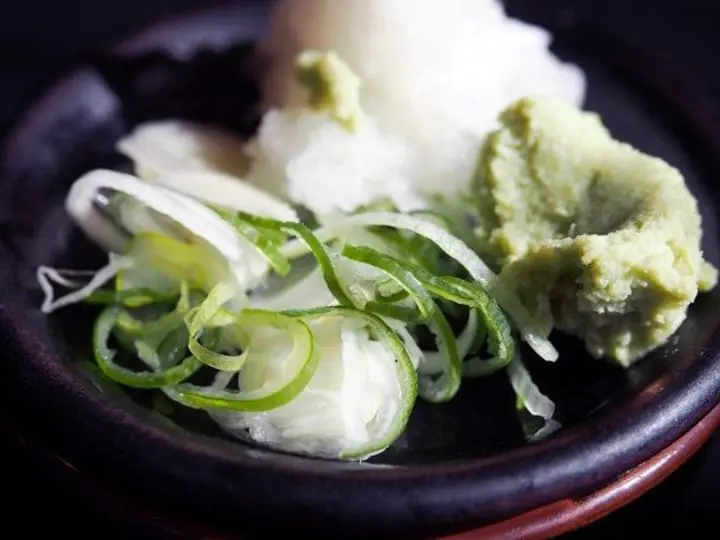
The condiments that are used in soba are spices and vegetables, and other food items, that bring out the best of the noodles' flavor. Spices like ichimi pepper, shichimi or seven spice blend, wasabi and green onions are the most commonly used; you can add these seasonings to suit your tastes.
Read also
What's Soba-yu?
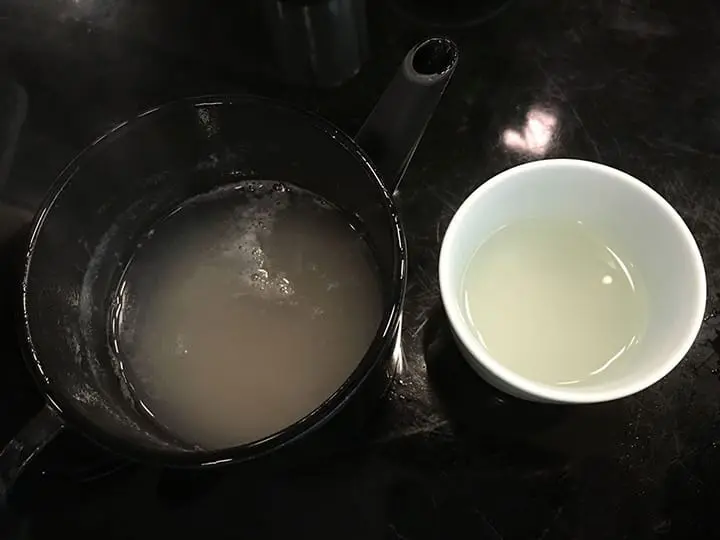
At some restaurants, once you have finished your soba, you may be served a small teapot-like container of soba-yu, or hot soba water. This is the water that the soba was cooked in, which is full of vitamins B1 and B2. It is also said that soba-yu contains lutin, a type of polyphenol antioxidants, which is good for your health as well. If you are given a pot of soba-yu, please drink some and see what you think.
As soba-yu does not have a distinct flavor of its own, if you have ordered zaru soba or mori soba and have leftover cold broth, then we recommend adding the soba-yu to that then drinking it. It will turn into a nice soup actually.
Unusual Soba
Other than the standard types of kake soba and zaru soba mentioned above, there are also some rather unusual ways of eating soba out there as well.
Soba-meshi
Soba-meshi is a dish where yakisoba (fried noodles with vegetables and meat) is mixed with rice. Not strictly a soba dish, it has however been gaining in popularity in recent years.
Soba-sushi
Soba-sushi is sushi where, instead of the usual vinegared rice, soba noodles are used. This dish is somewhat more refreshing tasting than common sushi.
Soba-sashimi
Not strictly noodles, soba sashimi are thin, flat rectangles of boiled and cooled soba dough served with soy sauce and wasabi the same way that standard fish sashimi is. As you can fully appreciate the subtle flavors of the buckwheat in this dish, it is quite popular in Japan.
Soba-inari
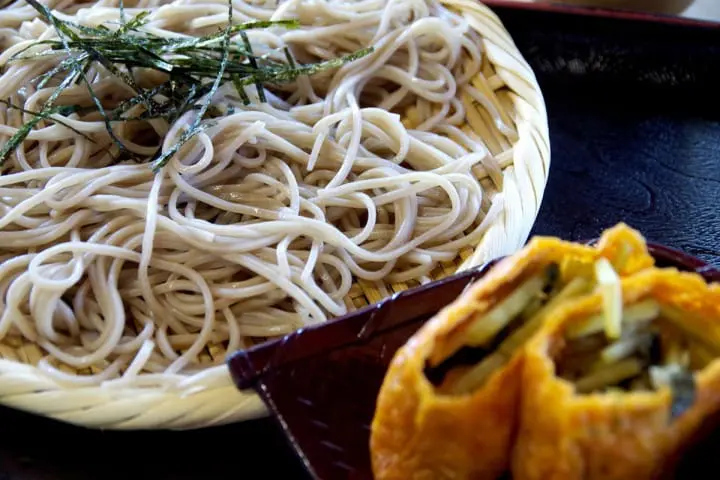
These sweet pouches of fried tofu are stuffed with diced soba noodles rather than the usual vinegared sushi rice. Soba-inari is more refreshing and lower in calories than standard Inari zushi.
Salad Soba
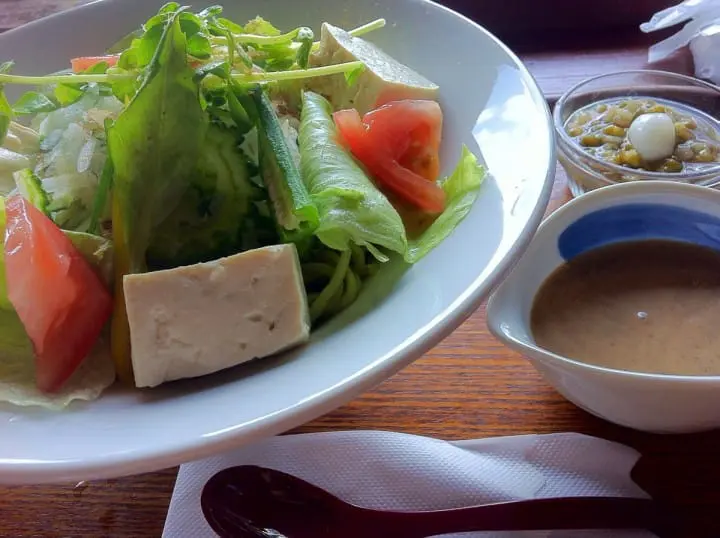
A cold soba dish, these noodles come with lettuce, tomato, and other vegetables, with salad dressing on top. This is a great, refreshing and light dish for the summer.
Soba Croquette
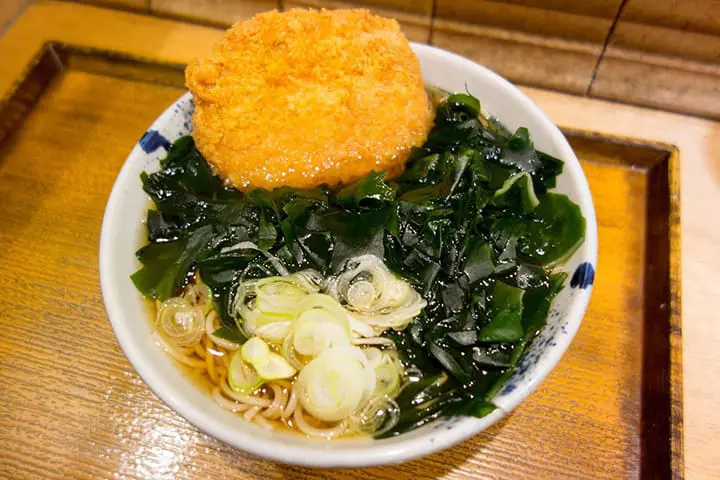
This is a hot kake soba served with croquette on top.
French Fry Zaru Soba
This is a set meal of soba noodles and French fries, which was invented in Osaka by the Hankyu Soba Wakana shop. The delicious combination of the fries soaked in dashi stock is what makes this particularly popular.
Japan-wide Regional Dishes
All across Japan, there are other characteristic ways of eating soba and of preparing soba which we will take a look at now.
Aomori/Tsugaru Soba
This dish features soba noodles that have been made with buckwheat flour and prepared mashed soybeans; once the dough for the noodles is prepared, it is allowed to mature for half a day before being prepared. The texture of this dish is very soft and springy, and the addition of the soybeans gives the noodles a hint of sweetness.
Niigata - Hegisoba
This is a type of soba where seaweed has been added to the dough. 'Hegi' refers to the type of container it is arranged in when served.
Fukushima - Tachisoba
This is a regional dish from Hinoematamura in Fukushima prefecture. Here, the noodles are much flatter and thicker than standard soba. They have a distinct springiness to them, giving them a great, substantial feeling when eaten.
Fukushima/Takato Soba
This is a truly unusual type of soba - rather than eating it with chopsticks, this soba is eaten with stalk of green onion. Not only that but the soup base is also quite different. It is made with a slightly spicy daikon radish base. This soba is considered to be a dish of good fortune; the green onion, which is called naganegi (long onion) in Japanese, is said to grant one long life.
Iwate/Wanko Soba
This is a way of eating soba that originated in Hanamaki city, in Iwate prefecture. It is an essentially never-ending bowl of soba - a small dish of soba that is constantly refilled by the staff standing and waiting on you as you take the noodles and dip them into a separate dish of tsuyu.
Nagano - Tojisoba
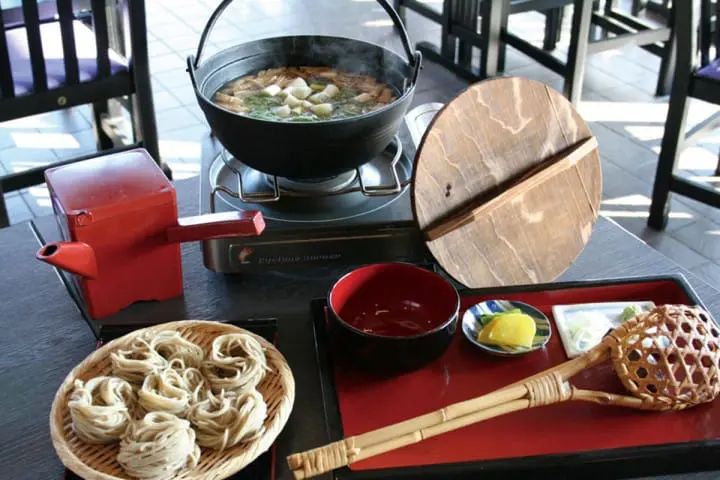
This dish features small mounds of noodles that you scoop up in a small, open-woven ladle and soak in a pot full of hot tsuyu before eating. This hot soba is a perfect match for cold wintery weather. And as there are plenty of vegetables and mushrooms in the hot tsuyu, it is also a very nutritious dish.
Shimane - Izumo Soba
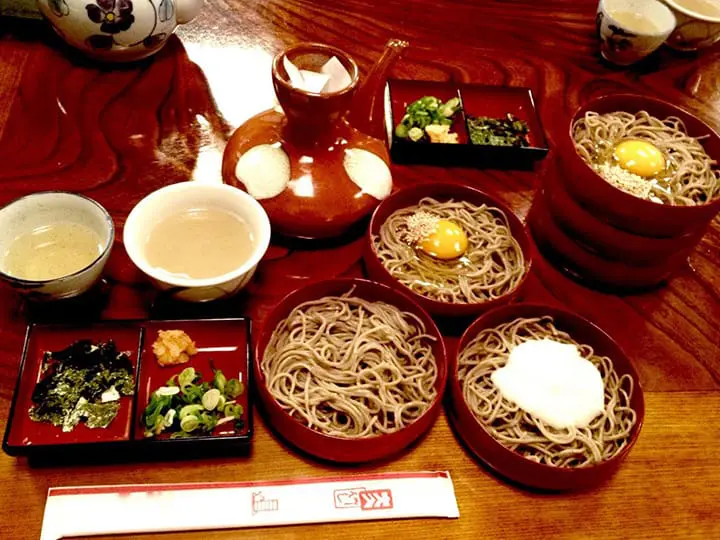
This is a soba dish eaten in the Izumo area of Shimane prefecture. These noodles are made in a manner that leaves some of the husks from the buckwheat in the flour, giving the noodles a distinctive darker color to them. They are eaten with tsuyu as usual.
Yamaguchi - Kawara Soba
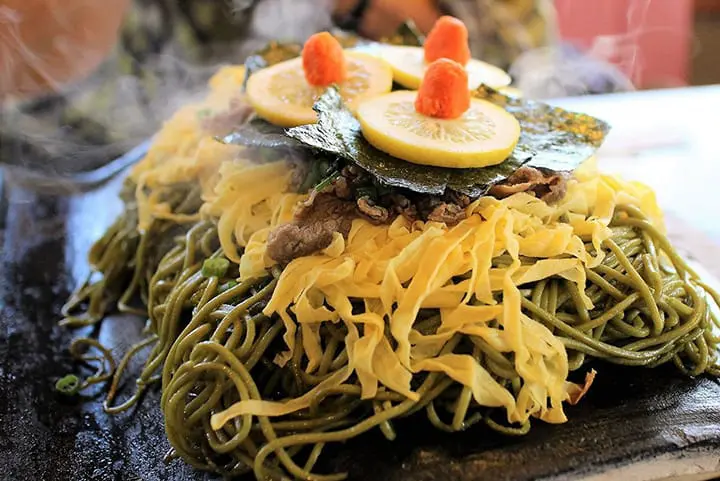
This is a soba dish of cha soba, with beef strips cooked in a salty-sweet sauce, thinly sliced omelet, green onions, grated daikon radish and chili, and dried seaweed strips served on a hot roof tile. This dish is eaten with a hot tsuyu sauce.
Nagasaki - Taishu Soba
This is a type of soba made from the buckwheat that is produced on Nagasaki's outlying island of Tsushima. These noodles have a much stronger flavor to them than standard soba.
Kagoshima/Satsuma Soba
This type of soba features noodles that have been made with 'jinenjo' (Japanese yam or yamaimo) as a filler and topped with Kagoshima's famous fried fish cakes or fried fish balls.
Okinawa - Okinawa Soba
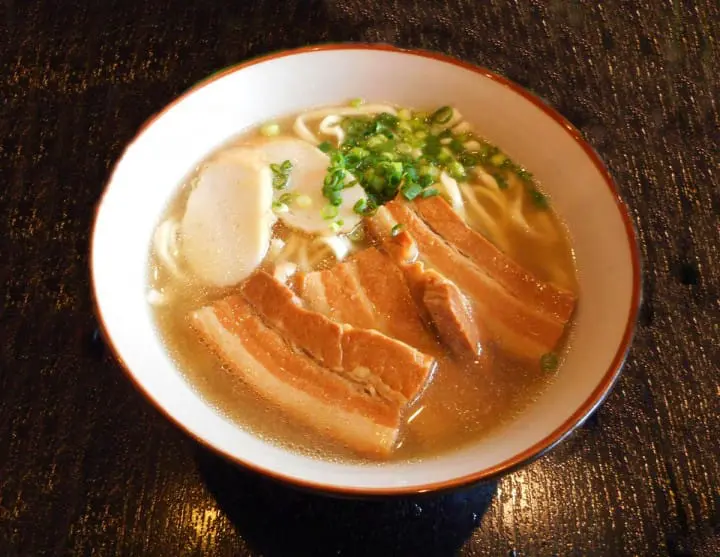
An original cuisine from Okinawa, which is not made with buckwheat flour but wheat flour and often eaten topped with another famous Okinawan dish, rafute (sweet stewed pork belly cubes). A Stunning Seaside View And Stellar Okinawan Soba At Kunnato has more information on this topic.
Differences in Soba in Kanto and Kansai
In both the Kanto region and Kansai region, there are subtle differences in the tsuyu, the flavoring made from soy sauce and dashi, that is used with both soba and udon.
In Kanto, the tsuyu is made with katsuobushi at the heart of the stock, with a strong soy sauce and mirin added to it; this tsuyu is quite dark in color and has a somewhat strong flavor to it. Kansai, on the other hand, starts from a kombu kelp based stock, and adds a diluted soy sauce to that, giving their tsuyu an overall lighter color but an effective flavor.
If you happen to be traveling through both regions, why not sample soba or udon from both Kansai and Kanto to see these flavor differences for yourself? Check out What Are The Differences Between Soba and Udon Noodles? for more about this.
How Much Soba Costs
The prices of soba vary from place to place and by what sort of topping they are served with. The lowest price soba chain shops tend to offer single dishes in the 300 to 600 yen range, while specialty stores can be priced between 600 to 1000 yen. High ranking restaurants may have soba dishes costing anywhere from 1000 to 2000 yen on their menus as well.
A rough estimate of the prices of popular types in most shops would be:
Kake soba: 300-800 yen
Zaru soba: 300-800 yen
Tempura soba: 500-800 yen
In general, if you have 1,000 yen, you will be able to enjoy almost all varieties of soba in any given shop.
If you are purchasing soba noodles only at the grocery store and making a dish yourself, a single serving of noodles will cost between 100 yen and 300 yen, depending on the brand and quality.
Chain Soba Restaurants
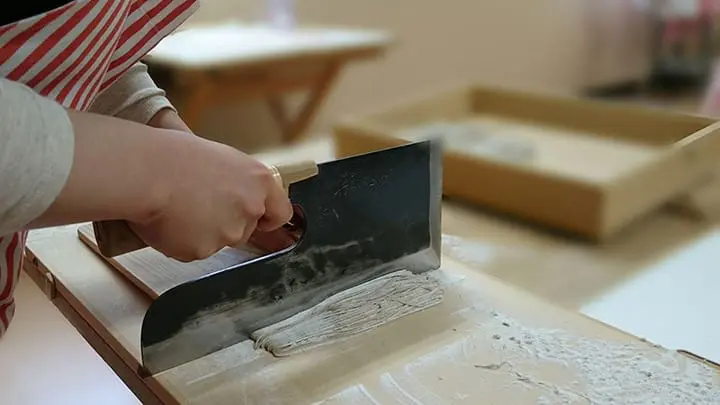
Fuji Soba, Yudetaro, Komoro Soba, and Hakone Soba are four of the most popular soba chain restaurants in Japan.
No matter which restaurant you select, they are going to have kakesoba starting from about 300 yen, which is an honest price indeed. For those traveling in Japan on a tight budget or with little appetite, these are excellent places to stop for a healthy meal.
Recommended Shops
Here are some of our recommended soba shops found throughout the Tokyo area.
Fukudaya (Shibuya)
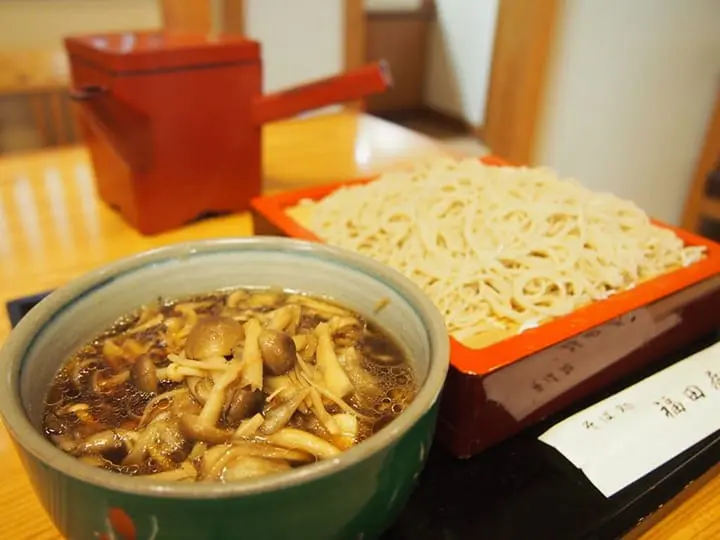
If you are in Tokyo's Shibuya area and are in the mood for soba, we recommend visiting Fukudaya, a shop with a 50 year long history. It is a shop where both men and women, young and old love to visit, and also has udon on the menu. Fukudaya, Soba restaurant in Shibuya has more on this amazing restaurant.
MatsuGen Ebisu (Ebisu)
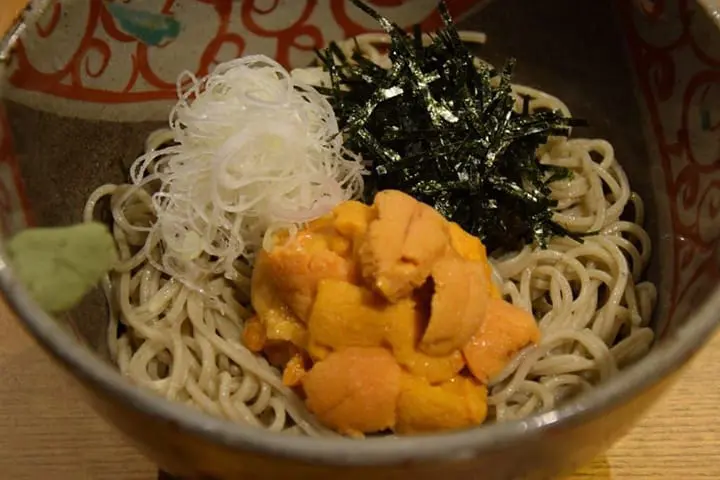
This shop, located in the popular Ebisu area of Tokyo, has soba, sukiyaki, and tempura on the menu - which also come in English, by the way. Our recommended dish here is their elegant and skillfully flavored sea urchin topped soba. Please look at this article for more on this delicious restaurant: "MatsuGen Ebisu": Soba and Japanese Cuisine from Selected Ingredients.
Namikiyabu Soba (Asakusa)
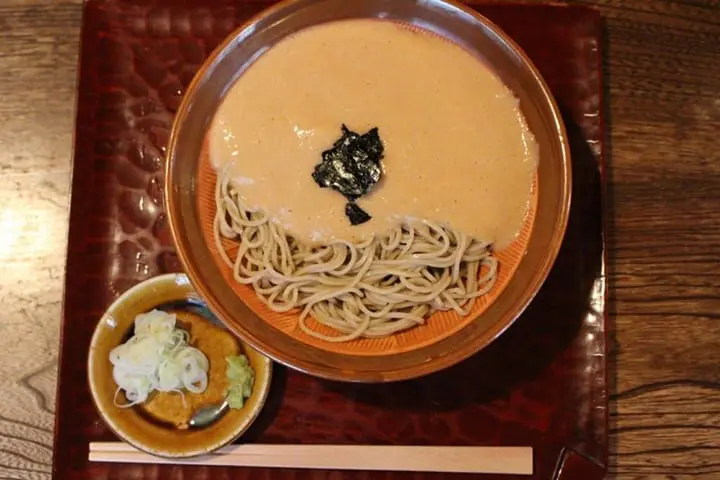
If you are getting hungry while sightseeing in Asakusa, then stop by Namikiyabu Soba, which is right by Kaminarimon. This shop was established in 1913 and is a prominent shop of longstanding in Tokyo. At this shop you can savor the aroma of the soba as you enjoy their flavorful noodles. Take a look at: Namikiyabu Soba: a 100 Year-Old Soba Shop Loved By Everyone! (Asakusa) for more information.
Takahashike

This restaurant, found on the World Heritage recognized Mount Takao has been offering tororo soba to travelers for over 170 years. With grated yamaimo and nagaimo and other types of Japanese yam combined and poured over these noodles, this tororo soba is said to give you a lot of stamina, making it the perfect food to eat when you are hiking up a mountain. Read the following article for more: Tasty Fuel For Your Mount Takao Hike: Takahashiya Tororo Soba.
Soba Allergy

Soba is considered to be a health food as it has plenty of vitamin B2 and dietary fiber in it. Rarely though, the proteins contained in buckwheat flour may cause individuals to have an allergic reaction.
For countries that do not have a tradition of eating soba or buckwheat flour-based products, there may be some that are not aware of buckwheat allergies. As a result, of the people that eat soba for the first time when in Japan, there may be a few tourists that unfortunately experience this.
If you have a soba allergy, within 10 minutes of eating the noodles you will experience pain inside your mouth, and the inside of your mouth or tongue will begin to swell. Your throat may also feel itchy, and you may notice other symptoms.
As time progresses, stomach pain, nausea, diarrhea, and other internal issues may occur; in severe cases, you may suffer from anaphylactic shock. If you start to have a strange sensation in your mouth while eating soba, stop eating and spit out or throw up what you have eaten right away, then drink as much water as possible.
Read also
Enjoy Yourself with Soba
Perhaps the greatest charm of soba is that slurped up with the right condiments, this is a dish that has been loved in Japan by the common people for generations. And without having the rigid etiquette of tea-ceremony dishes, soba is truly a dish that anyone can enjoy.





































![[2026] Top 5 Strawberry Picking Spots in Tokushima, Naruto| Farms and Access Guide for January to May](https://resources.matcha-jp.com/resize/720x2000/2025/03/06-227165.webp)
![[Yamanashi/ Hokuto City] 4 Hot New Spots Opening in 2026](https://resources.matcha-jp.com/resize/720x2000/2025/12/12-252747.webp)


